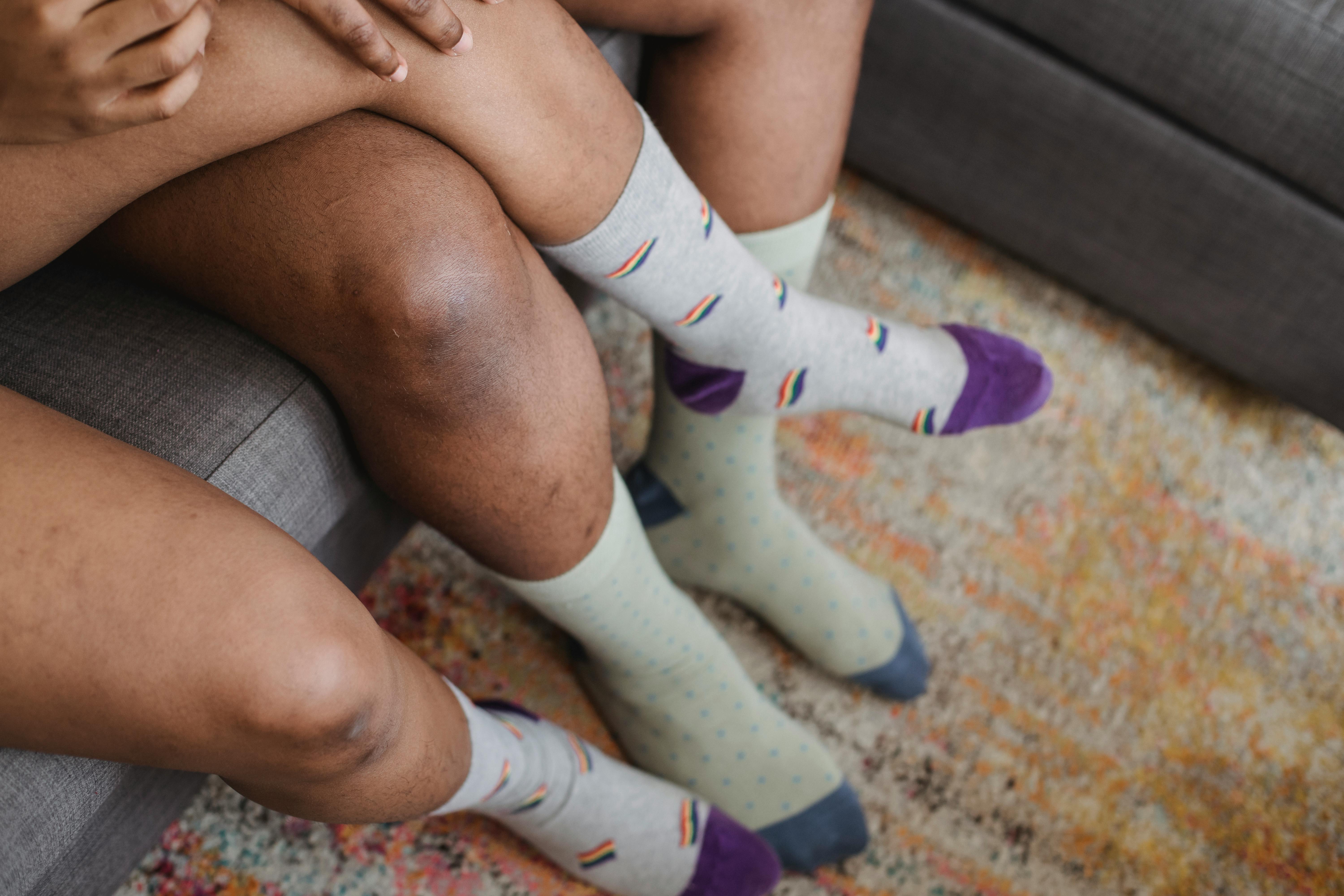Can Wearing Compression Socks Be Harmful

Wearing compression socks is becoming increasingly popular as a way to improve athletic performance, reduce swelling, and increase comfort. However, there are potential risks associated with wearing compression socks, and you should understand the potential risks before using them. This article will discuss the potential benefits and risks of wearing compression socks and provide guidance on how to safely use them.Compression socks are specialized hosiery designed to help increase blood circulation in the lower legs. They provide a snug fit around the ankle and calf, applying pressure that helps reduce swelling and improve circulation. Compression socks are commonly used by athletes, pregnant women, people with diabetes, and those who travel frequently or stand for long periods of time.
How Do Compression Socks Work?
Compression socks are specially designed to provide graduated, medical grade compression to the legs and feet. The pressure created by the socks helps reduce swelling and improve circulation throughout the legs. By providing a snug fit around the ankle and gradually decreasing up the leg, compression socks can help reduce fatigue and improve overall comfort. The snug fit of these socks also helps stabilize muscles to prevent injury or strain during activities like running or walking. Compression socks come in a variety of materials and styles, allowing users to choose the best option for their needs.
Compression socks work by applying pressure to areas of the leg where there is poor blood circulation. This pressure helps reduce swelling in the legs by increasing blood flow in affected areas. Additionally, by providing support to muscles, compression socks can reduce muscle strain and soreness caused by long periods of standing or sitting. Wearing compression socks may also help improve energy levels as they support circulation in your legs and feet, allowing them to move more efficiently throughout your day.
Overall, compression socks are designed to provide medical grade support for legs and feet while also helping reduce fatigue and discomfort caused by long periods of standing or sitting. By providing support through graduated pressure from ankle to calf, compression socks can help improve circulation throughout your body while also reducing swelling in the legs.
The Benefits of Wearing Compression Socks
Compression socks are a type of garment designed to help improve circulation in the feet and legs. They are becoming increasingly popular with athletes, travelers, and those who suffer from chronic venous disorders, as they offer a variety of benefits. Here are some of the main advantages of wearing compression socks:
Improved Circulation: Compression socks help improve circulation in the feet and legs by gently squeezing the veins and muscles. This encourages blood to flow more efficiently throughout the body, reducing swelling and fatigue. It can also help reduce pain caused by poor circulation.
Enhanced Performance: By improving circulation in the lower legs, compression socks can help improve athletic performance. Studies have shown that athletes who wear compression socks while running or engaging in other forms of physical activity experience improved endurance, reduced fatigue, and better overall performance.
Reduced Risk of Injury: By providing support to the muscles and tendons in the lower legs, compression socks can reduce the risk of injury during physical activity. The added support helps reduce strain on the joints and can prevent common injuries such as shin splints or Achilles tendinitis.
Improved Comfort: Compression socks provide an extra layer of comfort for those who spend long periods standing or sitting. By compressing your feet and legs, they help reduce swelling that can cause discomfort over time. They also provide extra cushioning for those standing on hard surfaces for extended periods.
Overall Health Benefits: Wearing compression socks regularly can provide a number of health benefits beyond improved circulation. Studies have shown that they can reduce inflammation and promote healing after injury or surgery. They may also help improve recovery times after strenuous exercise, allowing you to perform at your best without having to take time off for recovery.
The benefits offered by compression socks make them an ideal choice for athletes, travelers, or anyone looking to improve their overall health and wellbeing. With so many options available today, it’s easy to find a pair that fits your needs perfectly.
Risks of Wearing Compression Socks
Compression socks are socks designed to provide extra support and pressure to the feet and legs. They are commonly used to reduce swelling and fatigue, improve circulation, or provide support for medical conditions such as varicose veins, deep vein thrombosis (DVT), and lymphedema. While they can be beneficial for many people, there are some risks associated with wearing compression socks.
The most common risk associated with wearing compression socks is developing skin irritation or infection. This is because the tight fabric of the sock can cause friction against the skin, which can lead to redness, itching, blisters, or even an infection. To reduce this risk it is important to make sure that the compression socks fit properly and are not too tight around the ankles or calves. Additionally, it is important to wear clean compression socks every day and launder them regularly to prevent infections from developing.
Another risk associated with wearing compression socks is developing blood clots in the legs. Compression socks help improve circulation in the legs by squeezing them and pushing blood flow upwards. However, if they are too tight or worn for too long they can restrict blood flow instead of improving it, leading to blood clots in the veins. It is important to follow your doctor’s instructions when wearing compression socks and make sure that you do not wear them for longer than recommended in order to reduce this risk.
Lastly, another potential risk of wearing compression socks is nerve damage caused by prolonged pressure on certain areas of the foot or leg. Compression socks should be snug but not overly tight; if they are too tight it can cause numbness or tingling in certain areas due to nerve pressure. To reduce this risk it is important to make sure that your compression socks fit properly and that you remove them at least once a day in order to give your feet a break from the pressure.
Overall, while there are some risks associated with wearing compression socks it is important to remember that they can be beneficial for many people who suffer from medical conditions such as varicose veins or DVT. As long as you follow your doctor’s instructions and take precautions such as making sure your compression socks fit properly and removing them periodically throughout the day you should be able to enjoy their benefits without any adverse side effects.
Precautions to Take When Wearing Compression Socks
Compression socks are designed to improve circulation and provide support for the feet and legs. While they can be beneficial, there are some precautions that should be taken when wearing them. Here are some tips to keep in mind when wearing compression socks:
1. Make sure the fit is correct – Compression socks should fit snugly but not too tightly. They should not restrict blood flow or cause any discomfort. Measure your feet and calves before purchasing to ensure you get the right size.
2. Wear them gradually – Start by wearing the compression socks for only a few hours a day and then gradually increase the time you wear them as your body adjusts.
3. Avoid wearing them for too long – Don’t wear compression socks for more than 8 hours at a time as this can lead to decreased circulation and skin irritation. It’s also important to take them off at night so your feet can breathe and recover from the day’s activities.
4. Wash regularly – It’s important to wash your compression socks regularly to keep them clean and in good condition. Use a mild detergent and air dry them away from direct heat or sunlight as this can damage the fabric over time.
5. Seek medical advice – If you experience any discomfort, pain, or other symptoms while wearing compression socks, it’s best to seek medical advice from your doctor or health care provider before continuing use of the product

Alternatives to Wearing Compression Socks
If you suffer from poor circulation or painful swelling in your legs, you may be considering wearing compression socks. While compression socks are a great way to improve circulation and reduce swelling, they are not the only option. There are several alternatives that can provide relief without the need for wearing compression socks.
One alternative is to take a break from standing or walking for long periods of time. Taking regular breaks throughout the day can help reduce swelling and improve circulation in your legs. You can also try elevating your legs above your heart by lying down and propping up your feet with pillows or using a footstool while sitting. This will help reduce swelling and improve blood flow in your legs.
You can also try wearing loose-fitting clothing with wide leg openings that won’t restrict circulation in your lower legs. Make sure you choose materials that are breathable, like light cotton or linen, so that air can circulate around your skin and keep it cool and comfortable. Additionally, avoiding tight-fitting shoes or high heels can help reduce pressure on the veins in your feet and ankles.
Finally, regular exercise is an important part of improving circulation and reducing swelling in your lower legs. Aim for at least 30 minutes of moderate physical activity each day to keep blood flowing through your body. Walking, swimming, cycling, yoga, and other forms of exercise can all help keep your legs healthy and prevent problems associated with poor circulation such as varicose veins.
Who Should Not Wear Compression Socks?
Compression socks are a great way to improve circulation and help reduce the pain and swelling of varicose veins. However, there are certain people who should not wear compression socks. People with advanced peripheral arterial disease, venous ulcers, or certain skin conditions like dermatitis should not wear compression socks as they can worsen the condition. Compression socks are also not recommended for people who have had recent surgery, particularly on the lower legs or feet. It is important to consult with your doctor before wearing compression socks if you have any of these conditions.
People with diabetes may be at risk for developing poor circulation in their feet and legs, so it is important to consult a doctor before wearing compression socks if you have diabetes. Additionally, those who experience numbness in their feet or legs should not wear compression socks as they may cause further discomfort and exacerbate the condition.
Finally, pregnant women should avoid using compression socks unless specifically recommended by a medical professional. During pregnancy, increased levels of hormones can cause blood vessels to relax and increase blood flow to the lower extremities which can lead to swelling and discomfort. Compression socks may alleviate some of these symptoms but can also lead to increased risk of deep vein thrombosis (DVT). Therefore pregnant women should only wear compression stockings if advised by their doctor.
How Long Can You Wear Compression Socks?
Compression socks are designed to be worn for extended periods of time, but it is important to follow the manufacturer’s instructions when wearing them. Generally, compression socks should be worn for no more than 8 hours in a 24-hour period and should be removed for at least one hour after every 8 hours of wear. Additionally, it is important to consider the type of activity that you will be engaging in while wearing compression socks in order to ensure proper fit and effectiveness. For example, if you plan to engage in vigorous exercise or activities that require a lot of movement, you may need to adjust the pressure or duration of wear accordingly.
In general, it is recommended that compression socks not be worn overnight as this can lead to decreased circulation and cause other health complications. If you are experiencing swelling or discomfort due to prolonged sitting or standing during the day, it may be beneficial to wear your compression socks while sleeping. However, this should only be done under the supervision of a medical professional who can provide guidance on how long and at what level of pressure your compression socks should be worn.
Overall, how long you can wear your compression socks will depend on the type of activity you are engaging in and any specific medical conditions that you may have. It is always important to follow your doctor’s instructions when wearing your compression socks and make sure that they fit correctly in order to maximize their effectiveness.

Conclusion
In conclusion, compression socks can be beneficial for people with certain medical conditions, and are generally considered safe to wear. However, they are not for everyone and can be harmful in certain scenarios. Compression socks should only be worn under the guidance of a healthcare provider if you have any existing medical conditions that could be affected by them. Those with healthy legs may also benefit from wearing compression socks, but it is important to take into consideration any potential risks before doing so.
Overall, compression socks can be a helpful tool for improving blood flow and circulation, reducing swelling and pain, and preventing further complications in those with certain medical conditions. But as with any medical device or product, it is necessary to ensure that it is being used appropriately and safely before making the decision to wear them on a regular basis.
